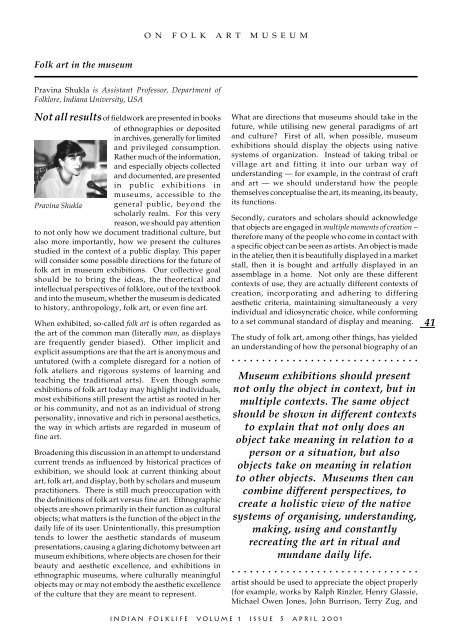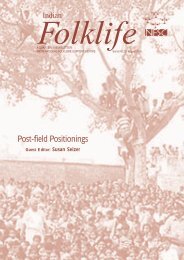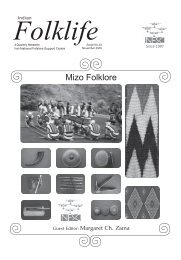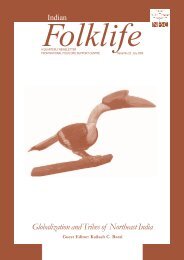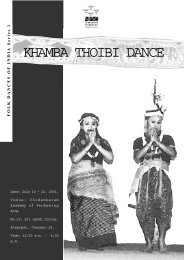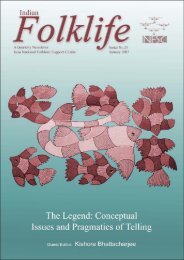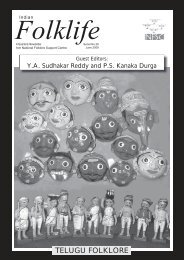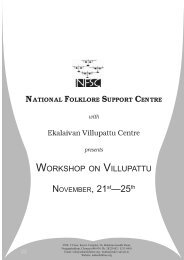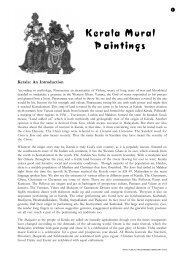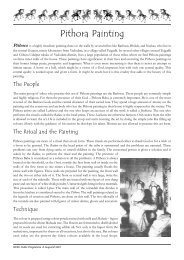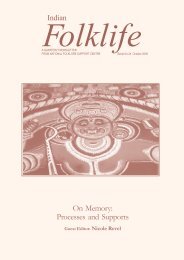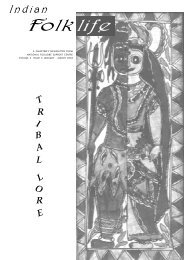ON CREOLIZATION40When you replace that question into the history of aspecific people like the Indo-Mauritians, it begins tolook more like a socio-linguistic problem, because youhave to examine the specific social conditions underwhich the development has occurred. Most important,though, is that we have to have adequate evidence ofthe socio-economic, political, cultural conditions inwhich people acquire each other’s traditions. Indo-Mauritians, Afro-Mauritians and Malagasy arrived inMauritius under entirely oppressive socio-economicconditions. We know a lot about the variety oflanguages among, for example, Indian indenturedlabourers; it has been well researched and documented.The status of the basic language for Indo-Mauritians isBhojpuri, which is a derivative of Hindi, and is spokenby a large number of Indo-Mauritians. I am told thatnowadays Bhojpuri is disappearing in favour ofEnglish. It is not rare to meet a middle-aged man whosemother cannot communicate with his daughter becausethey do not have a language in common; the daughterspeaks Creole and English and mother only Bhojpuri.Let us focus for a minute on the status of Bhojpuriamong Indo-Mauritians. In Mauritius, Bhojpuri isspoken by a fairly large number of people; it is alsospoken in Trinidad and in Guyana but it enjoys a higherstatus in Mauritius. It is associated to some extent withculture and religion. Indo-Mauritians tend to disregardtheir own culture in favour of Indian culture. That is,they tend to look to India for reference points as regardsculture and religion. But it is also true that Creole isprevalent and English is accorded a lot of prestige.English happens to be the official language of the nation,even though only few people have much command overthe language. So what I am coming to say is thatBhojpuri flourishes in a limited domain. The messagefor the folklorist is that in that limited domain, whatflourishes is not just any use of Bhojpuri, but the art ofthe word—in other words, proverbs, riddles, jokes,songs, folktales. These are the predominant constituentsof the domain of Bhojpuri. These are the things thatpeople let go of very slowly; they will hold on folkloreforms, forms of verbal art most retentively, because forordinary communication they only need Creole. So itis exactly in the realm of folklore or verbal art thatBhojpuri will flourish.This brings me to political implications. Bhojpurispeakers are aware that their language is on the way tobecoming a minority language with the passage of timedespite large numbers speaking the language. It isinteresting to think of the possibility that things likerumours, gossip, folktales, jokes, songs, rituals,euphemisms and other expression are a form of politicsfor the support network. It may be relevant to thework that you all do in the various parts of India thatthese arts of the word of the minority or threatenedlanguage are not merely survivors of something old,but are a form of politics. A great American folkloristused to refer to folklore as unofficial culture. Maybe thatis a relevant concept here. Unofficial culture has itsown history, its own literature, its own poetry; this isthe culture that is the province of the folklorist. So,you are entitled to look for the political implications ofthe arts of the word when studying people analogousto the Bhojpuri speakers in Mauritius.One last point. It is likely that folklore in Mauritius,and in creolised situations generally, exists in a situationthat is analogous to what linguists call diglossic.Diglossia is a fancy word for something that you arefamiliar with, namely a situation in which there is ademand for a universal or a national language, foruniversal literacy and unification of language. With thiscomes a division of opinion as to whether the high formor the low form should be used as the standard. Thesame kind of division of opinion is also seen withfolklore: on one hand, the disregard or scorn for folklorein comparison to high literature; on the other hand,the insistence that, as the Irish poet Yeats said, Folkloreis the soil within which all great art is rooted. But we usecreolization to describe what happens in a contactsituation between a ruling minority and a subjugatedmass; we do not use it to refer to just any mixing ofculture. In relation to official culture, it is likely thatfolklore exists the way diglossic languages exist, sideby side. This means that there is always going to be astruggle between the advocates of one and the other.You, the folklorists of this country, whether you like itor not, are advocates of minority culture. Many of youare sensitive to the political implications of the culturalexpression of the people whom you study.Despite the hundred and forty years of British rule inMauritius, Catholicism is especially prominent; thebishops and priests are quite influential. As I saidearlier, the most saintly figure in Mauritian history isPere Laval, a nineteenth century French Catholicmissionary, whose grave was visited by the Pope inNovember 1989. The grave is considered a pilgrimagesite not only by Catholic Creoles and Catholic Chinese,but also by Hindus and Muslims. It is a place wherepeople make what is called in Creole a promesse, a vowto perform a ceremony if your prayer isgranted. The custom was probablybrought to Mauritius by Hindus, not byCatholics. One can pray to the saint ormake offerings for being healed, whateverreligion one belongs to. You can call thisa case of syncretism, or you can call itcultural renegotiation, because it is aconscious adoption of someone else’scustom for your own purposes. To goanother step here: Hindu folk religion came intoexistence in Mauritius in the era of the indenturedlabourers. It is quite distinct from Hindu orthodoxy andthe Arya Samaj; it develops its variety according tolanguage so that folk Hinduism is distinct in Hindi,Tamil, Marathi, Gujarathi and Telugu, at least in thesefive groups; there are a number of sub-sects as well.In this case, religious differentiation follows linguisticdifferentiation.<strong>IN</strong>DIAN FOLKLIFE VOLUME 1 ISSUE 5 APRIL 2001
ON FOLK ART MUSEUMFolk art in the museumPravina Shukla is Assistant Professor, Department ofFolklore, Indiana University, USANot all results of fieldwork are presented in booksof ethnographies or depositedin archives, generally for limitedand privileged consumption.Rather much of the information,and especially objects collectedand documented, are presentedin public exhibitions inmuseums, accessible to thePravina Shuklageneral public, beyond thescholarly realm. For this veryreason, we should pay attentionto not only how we document traditional culture, butalso more importantly, how we present the culturesstudied in the context of a public display. This paperwill consider some possible directions for the future offolk art in museum exhibitions. Our collective goalshould be to bring the ideas, the theoretical andintellectual perspectives of folklore, out of the textbookand into the museum, whether the museum is dedicatedto history, anthropology, folk art, or even fine art.When exhibited, so-called folk art is often regarded asthe art of the common man (literally man, as displaysare frequently gender biased). Other implicit andexplicit assumptions are that the art is anonymous anduntutored (with a complete disregard for a notion offolk ateliers and rigorous systems of learning andteaching the traditional arts). Even though someexhibitions of folk art today may highlight individuals,most exhibitions still present the artist as rooted in heror his community, and not as an individual of strongpersonality, innovative and rich in personal aesthetics,the way in which artists are regarded in museum offine art.Broadening this discussion in an attempt to understandcurrent trends as influenced by historical practices ofexhibition, we should look at current thinking aboutart, folk art, and display, both by scholars and museumpractitioners. There is still much preoccupation withthe definitions of folk art versus fine art. Ethnographicobjects are shown primarily in their function as culturalobjects; what matters is the function of the object in thedaily life of its user. Unintentionally, this presumptiontends to lower the aesthetic standards of museumpresentations, causing a glaring dichotomy between artmuseum exhibitions, where objects are chosen for theirbeauty and aesthetic excellence, and exhibitions inethnographic museums, where culturally meaningfulobjects may or may not embody the aesthetic excellenceof the culture that they are meant to represent.What are directions that museums should take in thefuture, while utilising new general paradigms of artand culture? First of all, when possible, museumexhibitions should display the objects using nativesystems of organization. Instead of taking tribal orvillage art and fitting it into our urban way ofunderstanding — for example, in the contrast of craftand art — we should understand how the peoplethemselves conceptualise the art, its meaning, its beauty,its functions.Secondly, curators and scholars should acknowledgethat objects are engaged in multiple moments of creation –therefore many of the people who come in contact witha specific object can be seen as artists. An object is madein the atelier, then it is beautifully displayed in a marketstall, then it is bought and artfully displayed in anassemblage in a home. Not only are these differentcontexts of use, they are actually different contexts ofcreation, incorporating and adhering to differingaesthetic criteria, maintaining simultaneously a veryindividual and idiosyncratic choice, while conformingto a set communal standard of display and meaning.The study of folk art, among other things, has yieldedan understanding of how the personal biography of an○ ○ ○ ○ ○ ○ ○ ○ ○ ○ ○ ○ ○ ○ ○ ○ ○ ○ ○ ○ ○ ○ ○ ○ ○ ○ ○ ○ ○ ○ ○Museum exhibitions should presentnot only the object in context, but inmultiple contexts. The same objectshould be shown in different contextsto explain that not only does anobject take meaning in relation to aperson or a situation, but alsoobjects take on meaning in relationto other objects. Museums then cancombine different perspectives, tocreate a holistic view of the nativesystems of organising, understanding,making, using and constantlyrecreating the art in ritual andmundane daily life.○ ○ ○ ○ ○ ○ ○ ○ ○ ○ ○ ○ ○ ○ ○ ○ ○ ○ ○ ○ ○ ○ ○ ○ ○ ○ ○ ○ ○ ○ ○artist should be used to appreciate the object properly(for example, works by Ralph Rinzler, Henry Glassie,Michael Owen Jones, John Burrison, Terry Zug, and41<strong>IN</strong>DIAN FOLKLIFE VOLUME 1 ISSUE 5 APRIL 2001


